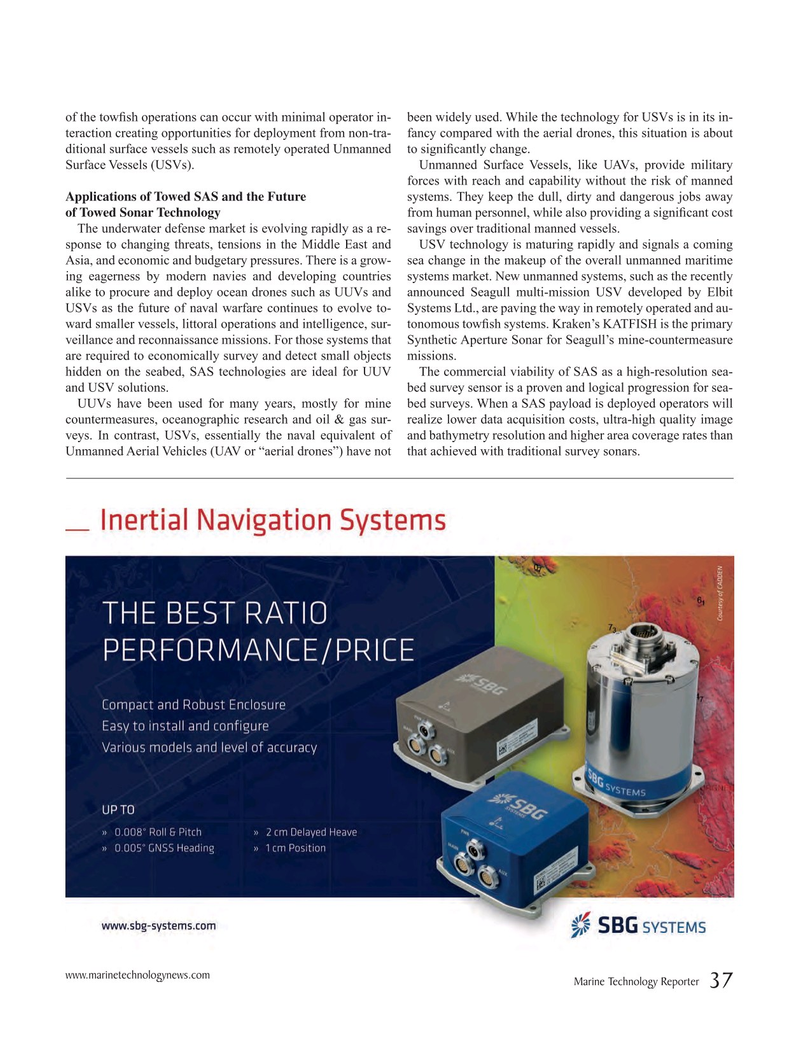
Page 37: of Marine Technology Magazine (March 2016)
Oceanographic Instrumentation: Measurement, Process & Analysis
Read this page in Pdf, Flash or Html5 edition of March 2016 Marine Technology Magazine
of the tow? sh operations can occur with minimal operator in- been widely used. While the technology for USVs is in its in- teraction creating opportunities for deployment from non-tra- fancy compared with the aerial drones, this situation is about ditional surface vessels such as remotely operated Unmanned to signi? cantly change.
Surface Vessels (USVs). Unmanned Surface Vessels, like UAVs, provide military forces with reach and capability without the risk of manned
Applications of Towed SAS and the Future systems. They keep the dull, dirty and dangerous jobs away of Towed Sonar Technology from human personnel, while also providing a signi? cant cost
The underwater defense market is evolving rapidly as a re- savings over traditional manned vessels.
sponse to changing threats, tensions in the Middle East and USV technology is maturing rapidly and signals a coming
Asia, and economic and budgetary pressures. There is a grow- sea change in the makeup of the overall unmanned maritime ing eagerness by modern navies and developing countries systems market. New unmanned systems, such as the recently alike to procure and deploy ocean drones such as UUVs and announced Seagull multi-mission USV developed by Elbit
USVs as the future of naval warfare continues to evolve to- Systems Ltd., are paving the way in remotely operated and au- ward smaller vessels, littoral operations and intelligence, sur- tonomous tow? sh systems. Kraken’s KATFISH is the primary veillance and reconnaissance missions. For those systems that Synthetic Aperture Sonar for Seagull’s mine-countermeasure are required to economically survey and detect small objects missions. hidden on the seabed, SAS technologies are ideal for UUV The commercial viability of SAS as a high-resolution sea- and USV solutions. bed survey sensor is a proven and logical progression for sea-
UUVs have been used for many years, mostly for mine bed surveys. When a SAS payload is deployed operators will countermeasures, oceanographic research and oil & gas sur- realize lower data acquisition costs, ultra-high quality image veys. In contrast, USVs, essentially the naval equivalent of and bathymetry resolution and higher area coverage rates than
Unmanned Aerial Vehicles (UAV or “aerial drones”) have not that achieved with traditional survey sonars.
www.marinetechnologynews.com
Marine Technology Reporter 37
MTR #2 (34-49).indd 37 2/19/2016 11:47:49 AM

 36
36

 38
38
